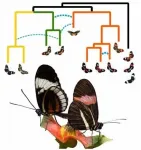Air-powered computer memory helps soft robot control movements
'Airhead' robot uses pneumatic RAM to play piano
2021-07-16
(Press-News.org) Engineers at UC Riverside have unveiled an air-powered computer memory that can be used to control soft robots. The innovation overcomes one of the biggest obstacles to advancing soft robotics: the fundamental mismatch between pneumatics and electronics. The work is published in the open-access journal, PLOS One.
Pneumatic soft robots use pressurized air to move soft, rubbery limbs and grippers and are superior to traditional rigid robots for performing delicate tasks. They are also safer for humans to be around. Baymax, the healthcare companion robot in the 2014 animated Disney film, Big Hero 6, is a pneumatic robot for good reason.
But existing systems for controlling pneumatic soft robots still use electronic valves and computers to maintain the position of the robot's moving parts. These electronic parts add considerable cost, size, and power demands to soft robots, limiting their feasibility.
To advance soft robotics toward the future, a team led by bioengineering doctoral student Shane Hoang, his advisor, bioengineering professor William Grover, computer science professor Philip Brisk, and mechanical engineering professor Konstantinos Karydis, looked back to the past.
"Pneumatic logic" predates electronic computers and once provided advanced levels of control in a variety of products, from thermostats and other components of climate control systems to player pianos in the early 1900s. In pneumatic logic, air, not electricity, flows through circuits or channels and air pressure is used to represent on/off or true/false. In modern computers, these logical states are represented by 1 and 0 in code to trigger or end electrical charges.
Pneumatic soft robots need a way to remember and maintain the positions of their moving parts. The researchers realized that if they could create a pneumatic logic "memory" for a soft robot, they could eliminate the electronic memory currently used for that purpose.
The researchers made their pneumatic random-access memory, or RAM, chip using microfluidic valves instead of electronic transistors. The microfluidic valves were originally designed to control the flow of liquids on microfluidic chips, but they can also control the flow of air. The valves remain sealed against a pressure differential even when disconnected from an air supply line, creating trapped pressure differentials that function as memories and maintain the states of a robot's actuators. Dense arrays of these valves can perform advanced operations and reduce the expensive, bulky, and power-consuming electronic hardware typically used to control pneumatic robots.
After modifying the microfluidic valves to handle larger air flow rates, the team produced an 8-bit pneumatic RAM chip able to control larger and faster-moving soft robots, and incorporated it into a pair of 3D-printed rubber hands. The pneumatic RAM uses atmospheric-pressure air to represent a "0" or FALSE value, and vacuum to represent a "1" or TRUE value. The soft robotic fingers are extended when connected to atmospheric pressure and contracted when connected to vacuum.
By varying the combinations of atmospheric pressure and vacuum within the channels on the RAM chip, the researchers were able to make the robot play notes, chords, and even a whole song--"Mary Had a Little Lamb" --on a piano. Click here to view a video of the robot playing piano.
In theory, this system could be used to operate other robots without any electronic hardware and only a battery-powered pump to create a vacuum. The researchers note that without positive pressure anywhere in the system--only normal atmospheric air pressure-- there is no risk of accidental overpressurization and violent failure of the robot or its control system. Robots using this technology would be especially safe for delicate use on or around humans, such as wearable devices for infants with motor impairments.
INFORMATION:
The paper, "A pneumatic random-access memory for controlling soft robots," is available here. The research was supported by the National Science Foundation.
ELSE PRESS RELEASES FROM THIS DATE:
2021-07-16
Imagine an orange cat. Now, imagine the same cat, but with coal-black fur. Now, imagine the cat strutting along the Great Wall of China. Doing this, a quick series of neuron activations in your brain will come up with variations of the picture presented, based on your previous knowledge of the world.
In other words, as humans, it's easy to envision an object with different attributes. But, despite advances in deep neural networks that match or surpass human performance in certain tasks, computers still struggle with the very human skill of "imagination."
Now, a USC ...
2021-07-16
BUFFALO, N.Y. - Many legacy media outlets played an unwitting role in the growth of the four most successful fake Twitter accounts hosted by the Russian Internet Research Agency (IRA) that were created to spread disinformation during the 2016 U.S. presidential campaign, according to a study led by a University at Buffalo communication researcher.
In roughly two years beginning in late 2015, these accounts went from obscurity to microcelebrity status, growing from about 100 to more than 100,000 followers. With its heavily populated follower base ready to spread the word -- like all heavily engaged Twitter audiences -- the IRA could strategically deploy messages and provide visible metrics, creating an illusion of authority and ...
2021-07-16
As the Covid-19 pandemic raged, news reports show that sales of electronic air cleaners have surged due to concerns about airborne disease transmission. But a research team at the Georgia Institute of Technology has found that the benefits to indoor air quality of one type of purifying system can be offset by the generation of other pollutants that are harmful to health.
Led by Associate Professor Nga Lee "Sally" Ng in Georgia Tech's School of Chemical and Biomolecular Engineering and the School of Earth and Atmospheric Sciences, the team evaluated the effect of a hydroxyl radical generator in an office setting. Hydroxyl radicals react with odors and pollutants, decomposing ...
2021-07-16
A team of researchers from the University of Maryland has 3D printed a soft robotic hand that is agile enough to play Nintendo's Super Mario Bros. - and win!
The feat, highlighted on the front cover of the latest issue of Science Advances, demonstrates a promising innovation in the field of soft robotics, which centers on creating new types of flexible, inflatable robots that are powered using water or air rather than electricity. The inherent safety and adaptability of soft robots has sparked interest in their use for applications like prosthetics and biomedical devices. Unfortunately, controlling the fluids that make these soft ...
2021-07-16
Evolution is often portrayed as a tree, with new species branching off from existing lineages, never again to meet. The truth however is often much messier. In the case of adaptive radiation, in which species diversify rapidly to fill different ecological niches, it can be difficult to resolve relationships, and the phylogeny (i.e. evolutionary tree) may look more like a bush than a tree. This is because lineages may continue to interbreed as new species are established, and/or they may diverge and then re-hybridize, resulting in genetically mixed populations (known as admixture). Even after species diverge, the introduction of genes from one species to another (known as introgression) can occur. All of ...
2021-07-16
A UC San Francisco study has found that the antibiotic azithromycin was no more effective than a placebo in preventing symptoms of COVID-19 among non-hospitalized patients, and may increase their chance of hospitalization, despite widespread prescription of the antibiotic for the disease.
"These findings do not support the routine use of azithromycin for outpatient SARS-CoV-2 infection," said lead author Catherine E. Oldenburg, ScD, MPH, an assistant professor with the UCSF Proctor Foundation. SARS-CoV-2 is the virus that causes COVID-19.
Azithromycin, a broad-spectrum antibiotic, is widely prescribed as a treatment for COVID-19 in the United States and the rest of the world. "The hypothesis is that it has anti-inflammatory properties that ...
2021-07-16
ATLANTA--An oral prodrug developed by a team of scientists led by Binghe Wang, Regents' Professor of Chemistry at Georgia State University, delivers carbon monoxide to protect against acute kidney injury, according to a new paper published in Chemical Science.
Although carbon monoxide (CO) gas is toxic in large doses, scientists have discovered it can have beneficial effects by reducing inflammation and protecting cells against injury. Previous studies have demonstrated the protective effects of CO against injury in the kidneys, lungs, gastrointestinal tract and liver, among other organs. For the past five years, Wang and his collaborators have worked to design a safe way to deliver CO to human patients via prodrugs -- inactive compounds that ...
2021-07-16
The COVID-19 pandemic knocked many women off schedule for important health appointments, a new study finds, and many didn't get back on schedule even after clinics reopened. The effect may have been greatest in areas where such care is already likely falling behind experts' recommendations.
The study, by health care researchers in the University of Michigan END ...
2021-07-16
The hydrothermal vent fluids from the Gorda Ridge spreading center in the northeast Pacific Ocean create a biological hub of activity in the deep sea. There, in the dark ocean, a unique food web thrives not on photosynthesis but rather on chemical energy from the venting fluids. Among the creatures having a field day feasting at the Gorda Ridge vents is a diverse assortment of microbial eukaryotes, or protists, that graze on chemosynthetic bacteria and archaea.
This protistan grazing, which is a key mechanism for carbon transport and recycling in microbial food webs, exerts a higher predation pressure at hydrothermal vent sites than in the surrounding deep-sea environment, a new paper finds.
"Our ...
2021-07-16
Vaccine negativity and reluctance didn't just emerge during the COVID-19 pandemic. In a recent study published in the Disaster Medicine and Public Health Preparedness journal, authors from Loyola University Maryland and Johns Hopkins Bloomberg School of Public Health explored the appearance of negative dominance - a concept in which negative messages outweigh positive, solution-oriented messages in audiences' perceptions - in the context of COVID-19 vaccine-related information and activity online.
Prior research has looked at media coverage to identify vaccine concerns among the public and its impact on vaccine-related beliefs and behaviors, the spread of misinformation and fake news on the Internet, and the role ...
LAST 30 PRESS RELEASES:
[Press-News.org] Air-powered computer memory helps soft robot control movements
'Airhead' robot uses pneumatic RAM to play piano



